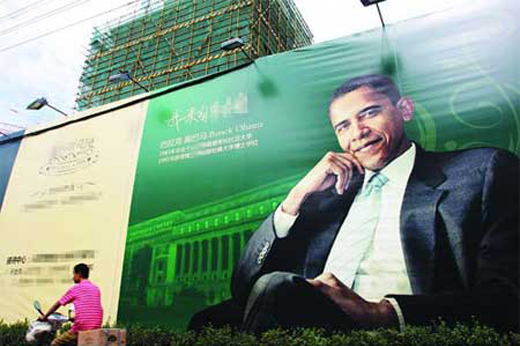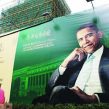
Obama’s China Trip: Forging Middle Class Ties
Publication: China Brief Volume: 9 Issue: 20
By:

Last April, in a press conference capping his first one hundred days in office, President Obama remarked that the "’ship of state’ is an ocean liner, not a speedboat," and that even a small shift in direction could have far-reaching consequences even a decade or two later [1]. When the President travels to Beijing next month on his maiden China trip, it may serve the President’s purposes to come up with a modern analogy befitting the Chinese regime. While President Obama is doing his utmost to steer the lumbering U.S.S. America in a slightly new direction, the Chinese leadership is performing a delicate balancing act, seeking to harness the powerful social forces below without letting them escape their control.
Among the many forces shaping China’s course of development, none will prove more significant in the long run than the emergence of a Chinese middle class. China’s ongoing economic transition from that of a relatively poor developing nation to a middle class country like the United States could have wide-ranging implications for every domain of Chinese life, especially for the country’s economy, politics, internal social cohesion and environment. From the party’s perspective, of course, an economically aspirant population can be a double-edged sword. The Chinese Communist Party (CCP) seems well aware that in other countries (e.g. South Korea, Indonesia) the middle classes have been known to push the envelope politically in favor of democratization. Yet the more important historical lesson for the party, ingrained over three decades of incremental reform, is that markets are here to stay and that only broadly shared prosperity can ensure social stability.
The challenge for U.S.-China relations is to prevent both sides from losing sight of their common aspirations, some lofty and others mundane. There are still many sticking points in the relationship—the Taiwan issue, ethnic tensions in Tibet and Xinjiang, religious freedom, trade disputes, environmental degradation, and overall U.S. unease with the prospect of a non-liberal, non-democratic superpower, among others—but areas of mutual interest and common opportunity are more numerous. The list includes global economic recovery, anti-terrorism and non-proliferation, and a wide range of regional and global strategic issues. Even climate change, certain to be near the top of the agenda during Obama’s visit, is a global challenge that the two sides are beginning to consider as an opportunity for cooperation. Moreover, in each of these areas, an increasingly diverse and pluralistic Chinese middle class may play a larger role in the policymaking process, both from within the party and through the application of external pressure. Fundamentally, 21st century China’s national aspiration—the construction of a xiaokang shehui (a reasonably well-off society), or what might be called a middle class nation—is a vision of historical progress not far from the American dream.
Forecasting the Growth of China’s Middle Class
Lest we forget, it was only eight years ago this summer, in July 2001, that Jiang Zemin proposed the formal admittance of capitalists into the party. By 2007, within the span of a single U.S. presidency, the percentage of China’s private entrepreneurs with CCP membership had soared to 37.8 percent (from an unofficial 13 percent in the late 1990s) [2]. Given that the party’s current membership is roughly 76 million, a mere 5 to 6 percent of China’s general population, private entrepreneurs already appear to be dramatically overrepresented [3]. For a nominally Communist country whose political structure still resembles Cuba’s and Vietnam’s, these are counterintuitive numbers.
Estimates vary widely on the exact size and composition of today’s Chinese middle class, but the consensus view is that it does exist and that it is expanding at a rapid clip. Among Western analysts, opinions tend to fall along a spectrum, the optimistic extreme marked by a strain of wishful thinking focused on China’s massive emerging consumer market, and the pessimistic one marked by ideological dogma or a gloomy sort of myopia. Emblematic of the former are analyses like a 2006 report by the McKinsey Global Institute, a research unit of McKinsey & Company, which forecasted 100 million middle class households in China by 2009 (45 percent of the urban population) and 520-612 million by 2025 (over 76 percent of the urban population) [4]. In recent years other firms and banks, including Merrill Lynch (2006) [5], HSBC and Master Card (2007), and the Deutsche Bank Research team (2009) [7], have made similarly upbeat, if usually more modest, predictions. These studies define the middle class according to income and tend to adopt best-case scenario models.
At the pessimistic end of the spectrum lie the more skeptical assessments of the Chinese middle class. Some Western analysts beholden to ideological biases simply refuse to accept that Communist China could produce a middle class structurally similar to its Western peers. In their estimation, economic freedom goes hand in hand with political freedom, and any definition of political freedom includes multiple parties and free elections. Others adopt a more sophisticated, if equally pessimistic, view that the true beneficiaries of the China boom have been the entrenched party elite—those able to translate political capital into economic capital. It is through an unholy alliance of wealth and power, what the Chinese sociologist Sun Liping calls a “wicked coalition,” that a small, well-connected minority gets rich while the average citizen suffers [8]. Lang Xianping, a U.S.-educated, Hong Kong-based economist known as Larry Lang on his popular talk show, has lent his voice to these popular frustrations by coining the term “black collar class,” a social stratum of urbanites who dress in black, drive black luxury sedans, have hidden incomes and ties to criminal elements, live secret lives with mistresses, and generally operate in an opaque manner [9].
At each extreme there is a grain of truth, but the stories of rampant corruption, in all of their gory detail, risk clouding out the reform period’s more mundane achievements. China’s emerging middle class is a complex mosaic of groups and individuals, some undoubtedly the clients of political patrons, but the overwhelming majority are the spitting image of self-made success. According to several recent surveys of the middle class conducted by well-regarded Chinese sociologists, a significant proportion of rural and urban private entrepreneurs came from peasant backgrounds and/or received very little education. A Chinese Academy of Social Sciences (CASS) survey conducted by Lu Xueyi and others found that 69 percent of the entrepreneurs in rural areas came from peasant backgrounds, and 54 percent were themselves former peasants [10]. In the late 1990s two studies of private entrepreneurs in Shanghai found that a majority of entrepreneurs—83 percent in one study and 44 percent in the other—received at most a middle school education [11]. Corruption and issues of fairness and opportunity are certainly among the country’s most serious problems, but unlike in the Russian case China’s market transition has avoided a wholesale transfer of wealth and power to a small oligarchy.
U.S.-China Relations: Forging Middle Class Ties
In the context of the global financial crisis, China’s domestic consumption has taken on new meaning. With the U.S. economy still bleeding jobs and the U.S. savings rate inching upward, the entire world is hoping that China might fill the demand vacuum and lead a global economic recovery. Just as the highly acquisitive U.S. middle class fueled global growth for many years, it stands to reason that a burgeoning Chinese middle class could help to catalyze economic recovery and lay the groundwork for a more balanced global economy in the future. In his address to the U.N. General Assembly last month Chinese President Hu Jintao reiterated the PRC’s commitment to raising China’s domestic demand, and highlighted the importance of its domestic consumption [12]. Beyond helping to drive the world economy, a universal consideration, this development would clearly be of commercial interest to U.S. corporations.
On the many issues likely to define the 21st century—a global fight against climate change, increasing worldwide demand for dwindling natural resources, and an ever more complex and interconnected global economy—China will need to play an increasingly proactive and constructive leadership role. Given the enormous environmental costs of the American middle class lifestyle, the Chinese should implement smart policies to ensure that its middle class develops in a more sustainable fashion. The U.S. should keep in mind that China’s ability to play this role, to truly become a “responsible stakeholder” in the international order, will depend on its evolving domestic circumstances. Perhaps the most serious threat to social stability in China today—the yawning gap between the rich and poor—might dissipate as a middle glass takes shape in between. As for the prospect of political change, whether or not the party relinquishes its “leading role” in society, an economically comfortable Chinese population is certain to demand greater voice and an acceleration of improvements in governance already under way.
Conclusion
Focusing on the middle class may be a way to find more common ground in U.S.-China relations. As mundane as it may be to promote the bourgeois way of life, commodious living is, as Thomas Hobbes observed centuries ago, a common aspiration that transcends our cultural and political differences. Moreover, a deeper understanding of the true motive force of China’s rise—an ancient civilization’s yearning to provide for its people and flourish once again—may dispel some of the alarmist views of a rising China. In the coming years, as the United States and China are called on to collaborate more frequently, leaders on both sides would do well to keep the shared aspirations of their people in mind.
Notes
1. “Barack Obama news conference — the full transcript,” Los Angeles Times, April 29, 2009, https://latimesblogs.latimes.com/washington/2009/04/barack-obama-news-conference-text.html.
2. The CCP had been recruiting private entrepreneurs unofficially since the 1980s. Bruce Dickson and Jie Chen, “Allies of the State: Democratic Support and Regime Support among China’s Private Entrepreneurs,” The China Quarterly, Vol. 196, (December 2008).
3. “Xin zhongguo chengli 60 nian lai zhongguo gongchandang dangyuan zengjia 16 bei zongshu jin 7600 wan ming,” [Total Membership in the Chinese Communist Party has increased 16-fold in the 60 Years since its Founding and Approaches 76 million], June 30, 2009, https://cpc.people.com.cn/GB/64093/64387/9569767.html.
4. McKinsey Global Institute, “From ‘Made in China’ to ‘Sold in China’: The Rise of the Chinese Urban Consumer,” November 2006, https://www.mckinsey.com/mgi/publications/china_consumer/index.asp.
5. Merrill Lynch, China Consumer Brands Participation Certificate, (Singapore: April 2008).
6. See https://www.singtaonet.com/chinafin/200712/t20071210_688541.html.
7. Steffen Dyck, Syetarn Hansakul, and Rachna Saxena, Deutsche Bank Research, Current Issues Asia, “Emerging Asia’s Middle Class A Force to be Reckoned with,” August 21, 2009. https://www.dbresearch.com/PROD/DBR_INTERNET_EN-PROD/PROD0000000000245808.PDF.
8. Zhongguo xinwen zhoukan [China Newsweek], January 13, 2006; Liaowang [Outlook], December 5, 2005; also see www.chinesenewsnet.com, December 12, 2005.
9. See https://www.chnqiang.com/article/2009/0516/article_83019_2.shtml.
10. Lu Xueyi and others, “Woguo shiyou qiye de jingying zhuangkuang yu siyou qiyezhu de qunti tezhen” [Operational Conditions of Private Enterprises in China and the Group Characteristics of Private Entrepreneurs], Zhongguo shehui kexue [Social Sciences in China], no. 4 (1994): 70.
11. Chen Baorong, “Jiushi niandai Shanghai geti siying jingji fazhan yanjiu” [Study of the Development of the Private Economy in Shanghai during the 1990s], working paper, Shanghai Academy of Social Sciences, 1994; and Zhu Guanglei, Dangdai zhongguo shehui gejieceng fenxi [Analysis of Social Strata in China], (Tianjin: Renmin chubanshe, 1998), p. 376.
12. “Chinese president addresses UN General Assembly, meets Russian, S Korean presidents,” Xinhua News, September 24, 2009, https://news.xinhuanet.com/english/2009-09/24/content_12106467.htm.





